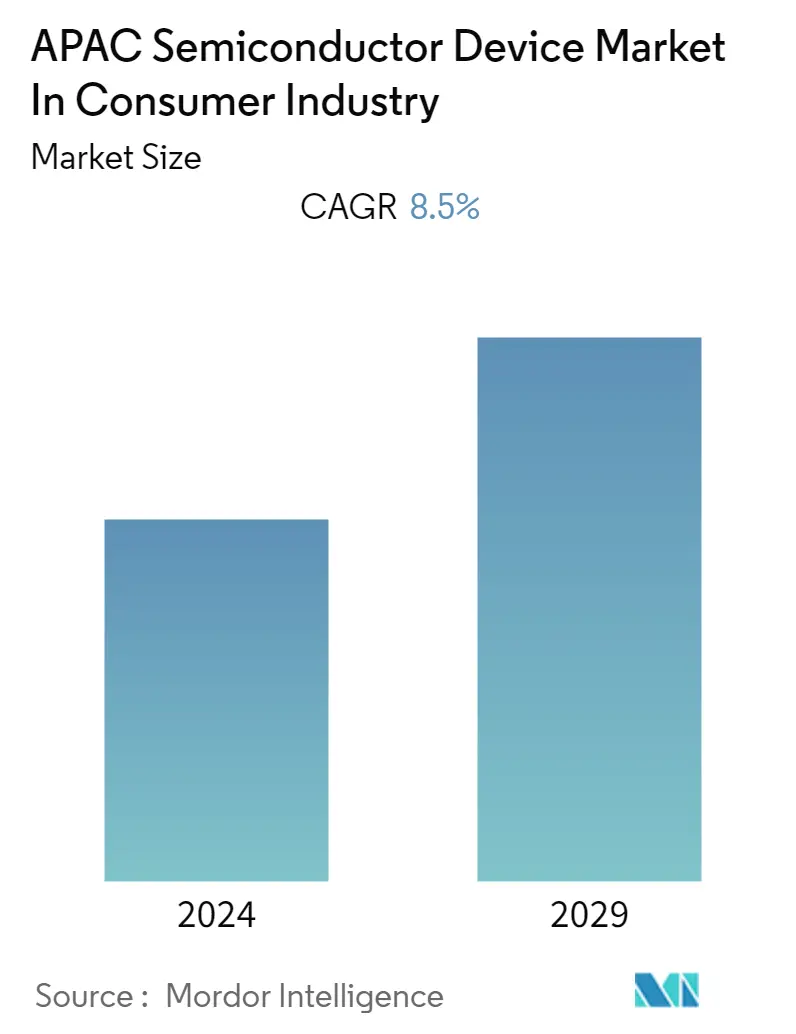Market Size of APAC Semiconductor Device Industry In Consumer Industry

| Study Period | 2019 - 2029 |
| Base Year For Estimation | 2023 |
| Forecast Data Period | 2024 - 2029 |
| Historical Data Period | 2019 - 2022 |
| CAGR | 8.50 % |
| Market Concentration | Low |
Major Players*Disclaimer: Major Players sorted in no particular order |
Need a report that reflects how COVID-19 has impacted this market and its growth?
APAC Semiconductor Device Market Analysis
The Asia Pacific Semiconductor device market in the consumer industry was valued at USD 52.96 billion in the current year and is expected to grow at a CAGR of 8.5% during the forecast period to become USD 86.4 billion by the end of the forecast period. Consumer electronics is the fastest-growing segment, contributing to market expansion. The expansion of smartphones, which is predicted to increase with population growth, is the key driving force for this market. Consumer electronics are driving the industry due to increased demand for products like tablets, smartphones, laptop computers, and wearable gadgets. As semiconductor technology advances, new market areas, like Machine Learning (ML), are rapidly being integrated.
Semiconductor devices are widely used in home appliances to increase efficiency and reduce power consumption. These devices include diodes, transistors, and integrated circuits (ICs). For instance, diodes are used in refrigerators, air conditioners, and washing machines to convert AC voltage to DC voltage, thereby improving energy efficiency. The use of semiconductors in home appliances has made them more affordable and environmentally friendly, reducing energy costs and carbon emissions.
According to the National Bureau of Statistics of China, In December 2022, retail sales of household appliances and consumer electronics in China totaled over CNY 79 billion. Further, Midea Group, a Chinese firm, was one of the world's largest household appliance companies in 2022, with a total sales value of roughly USD 51 billion. Gree Electric Appliances, another Chinese manufacturer, came in with a total sales value of almost USD 28 billion. Such huge sales of home appliances would create a demand for the studied market
Smartphone demand has significantly increased in recent years, particularly in emerging economies like India. Additionally, the introduction of 5G-enabled smartphones and the burgeoning demand for telecom and auto automation systems are driving up the demand for 5G chipsets in developed economies. Therefore, it is assumed that the semiconductor devices may experience strong growth during the forecast period due to the rising production of 5G chipsets. The development of highly processing microchips or microprocessors is expected to attract increasing investments from market participants like Intel Corporation and Infineon Technologies AG, which is expected to drive up product demand in the semiconductor device market.
On the flip side, the semiconductor industry is considered to be one of the most complex industries, due to more than 500 processing steps involved in the manufacturing and several products, but also the harsh environment it faces. For instacne, the volatile electronic market and the unpredictable demand. Depending on the complexity of the manufacturing process, there can be up to 1,400 process steps in the overall manufacturing of semiconductor wafers alone. Transistors are manufactured on the lowest layer, but the process is repeated as several layers of circuits are formed to create the final product. The complexity of manufacturing semiconductor devices is likely to restrain the growth of the studied market.
The COVID-19 pandemic also had a significant impact on the semiconductor devices market. The industry faced several supply chain issues and fluctuations in the availability and prices of raw materials. According to the Semiconductor Industry Association, the semiconductor industry began its recovery after 2021. Despite logistical challenges related to COVID-19, semiconductor facilities located in Asia-Pacific are anticipated to continue to function normally with high-capacity rates.
